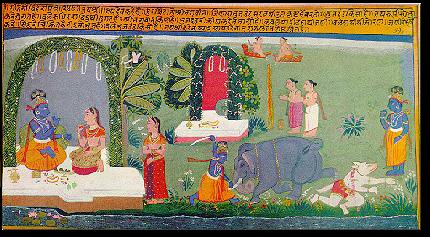Jayadeva returns to the mood of devotion and prayerful rejoicing. In the last verses of each prabandha with utmost dexterity and command, Jayadeva alternates between intense passion and intense devotion and invocation.
After the benedictory verse, two verses described Radha; now Hari is invoked as the killer of the demons Kamsa's elephant, Mura and others. The verse reads,
"It seems worshipped with mandara flowers
scattered by Triumph (jaya)
Self marked with sindhura (vermilion)
as a sign of joy in battling the elephant
Playfully slaying demon Kamsa's elephant
with an embrace of arms
Dripping with splattered blood
the stern arm of Mura's foe triumphs"
The play on the word 'Jaya' is the poetic unity of the verse. The last line can also be translated as:
"The splattered blood on Madhava's arms
Was as if Laksmi herself
Had flung a garland of blood-red flowers
Upon His arms and around Hari."
It is in this second meaning that the Hindi version written as the superscription understands the verse. An understanding of the details of the verbal virtuosity are necessary for identifying the details of the painting.
The two arched bowers, one with Krsna and Radha and the other empty are repeated. Radha and Krsna face each other with formality; the sakhi stands on the ground outside. Kama shoots his arrows from a tree adjoining and not distant as elsewhere. The arrangement and the motifs are by now standard. The specific nuance and multiple level meaning of the verse (which appears in Kumbha's and other longer recensions and not in the shorter ones) is transfigured into the pictorial situation by portraying Krsna twice, once as the vanquisher of the elephant of king Kamsa, and again as Mura's foe. Two devotees appear paying obeisance to the empty arched bower with a garland prominently spread, and a vertical floral garland which ascends to the upper celestial spheres where souls who have attained salvation float in boats. The image of the splattered blood of evil killed which is Laksmi's power and the constant remembrance of devotees, the floral pillar and the celestial regions are all contained in this pictorial. The artist exhibits an informed and deep comprehension of the depth of meaning of the poetic phrase.
|
